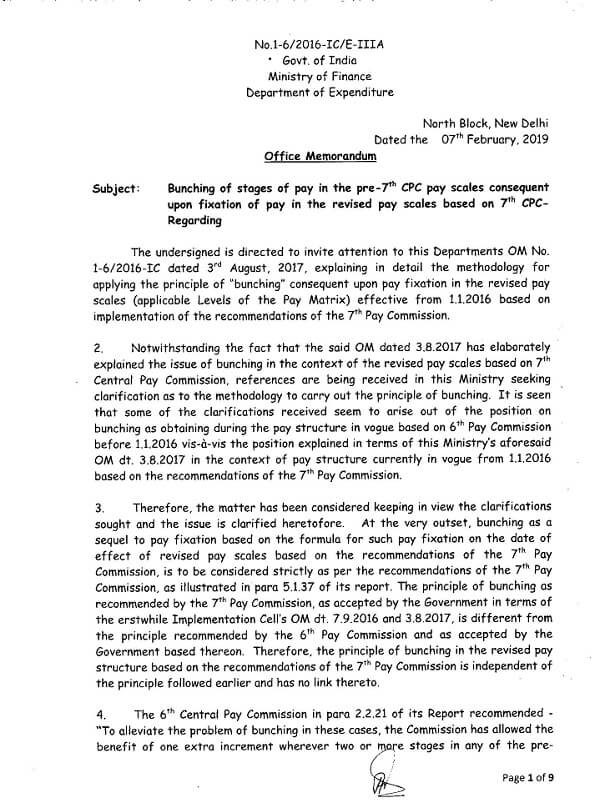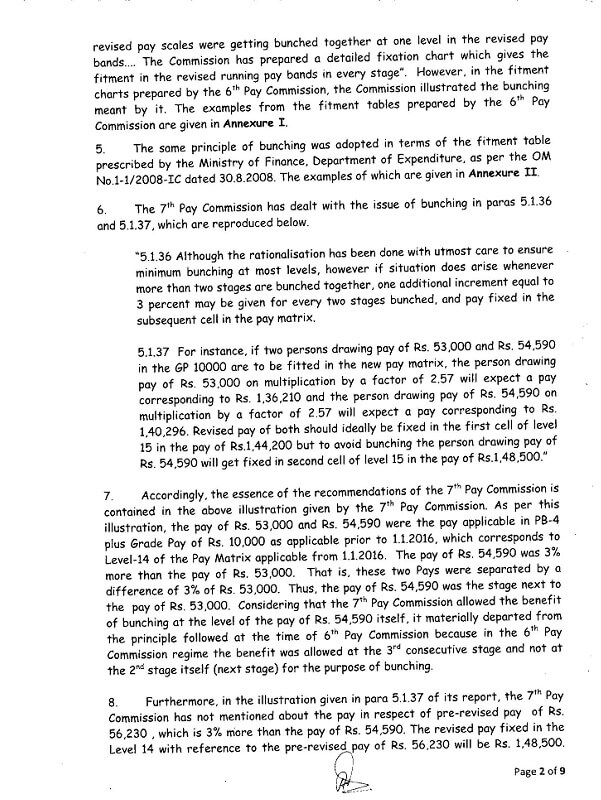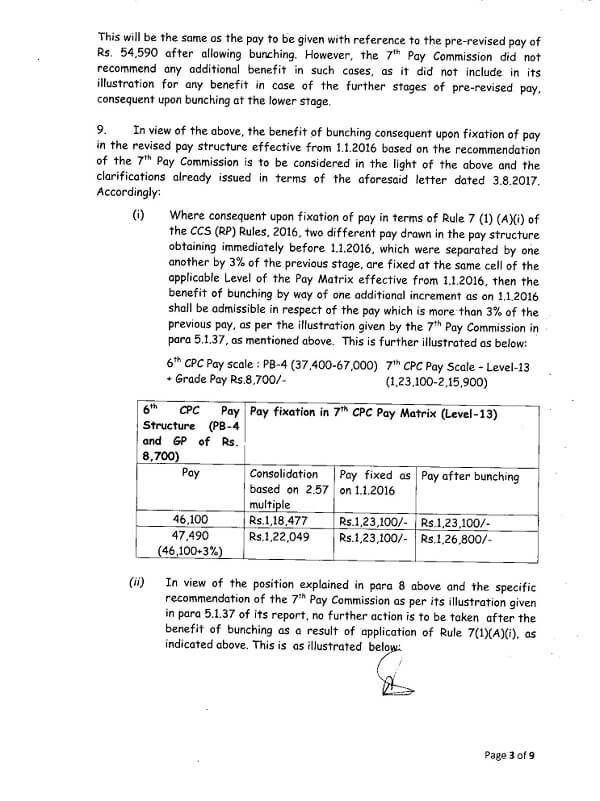7th CPC Pay Revision: Bunching of stages of Pay in the pre-7th CPC Pay scales in revised pay scales – FinMin Clarification dated 07.02.2019
No.1-6/ 2016-IC/E-IIIA
Govt. of India
Ministry of Finance
Department of Expenditure
North Block, New Delhi
Dated the 07th February, 2019
Office Memorandum
Subject: Bunching of stages of pay in the pre-7th CPC pay scales consequent upon fixation of pay in the revised pay scales based on 7th CPC Regarding
The undersigned is directed to invite attention to this Departments OM No. 1-6/ 2016- C dated 3rd August, 2017, explaining in detail the methodology for applying the principle of “bunching” consequent upon pay fixation in the revised pay scales (applicable Levels of the Pay Matrix) effective from 1.1.2016 based on implementation of the recommendations of the 7th Pay Commission.
2. Notwithstanding the fact that the said OM dated 3.8.2017 has elaborately explained the issue of bunching in the context of the revised pay scales based on 7th Central Pay Commission, references are being received in this Ministry seeking clarification as to the methodology to carry out the principle of bunching. It is seen that some of the clarifications received seem to arise out of the position on bunching as obtaining during the pay structure in vogue based on 6th Pay Commission before 1.1.2016 vis-a-vis the position explained in terms of this Ministry’s aforesaid OM dt. 3.8.2017 in the context of pay structure currently in vogue from 1.1.2016 based on the recommendations of the 7th Pay Commission.
3. Therefore,the matter has been considered keeping in view the clarifications sought and the issue is clarified heretofore. At the very outset, bunching as a sequel to pay fixation based on the formula for such pay fixation on the date of effect of revised pay scales based on the recommendations of the 7th Pay Commission, is to be considered strictly as per the recommendations of the 7th Pay Commission, as illustrated in para 5.1.37 of its report. The principle of bunching as recommended by the 7th Pay Commission, as accepted by the Government in terms of the erstwhile Implementation Cell’s OM dt. 7.9.2016 and 3 .8.2017, is different from the principle recommended by the 6th Pay Commission and as accepted by the Government based thereon. Therefore,the principle of bunching in the revised pay structure based on the recommendations of the 7th Pay Commission is independent of the principle followed earlier and has no link thereto.
4. The 6th Central Pay Commission in para 2.2.21 of its Report recommended – “To alleviate the problem of bunching in these cases,the Commission has allowed the benefit of one extro increment wherever two or stages in any of the pre-revised pay scales were getting bunched together at one level in the revised pay bands…. The Commission has prepared a detailed fixation chart which gives the fitment in the revised running pay bands in every stage”. However . in the fitment charts prepared by the 6th Pay Commission, the Commission illustrated the bunching meant by it. The examples from the fitment tables prepared by the 6th Pay Commission are given in Annexure I
5. The same principle of bunching was adopted in terms of the fitment table prescribed by the Ministry of Finance, Department of Expenditure, as per the OM No.1-1/2008-IC dated 30.8.2008. The examples of which are given in Annexure II.
6. The 7th Pay Commission has dealt with the issue of bunching in paras 5.1.36 and 5.1.37, which are reproduced below.
“5.1.36 Although the rationalisation has been done with utmost care to ensure minimum bunching at most levels, however if situation does arise whenever more than two stages are bunched together ,one additional increment equal to 3 percent may be given for every two stages bunched, and pay fixed in the subsequent cell in the pay matrix.
5.1.37 For instance , if two persons drawing pay of Rs. 53 ,000 and Rs. 54,590 in the GP 10000 are to be fitted in the new pay matrix , the person drawing pay of Rs. 53.000 on multiplication by a factor of 2.57 will expect a pay corresponding to Rs. 1,36,210 and the person drawing pay of Rs. 54,590 on multiplication by a factor of 2.57 will expect a pay corresponding to Rs. 1,40 .296 . Revised pay of both should ideally be fixed in the first cell of level 15 in the pay of Rs.1.44,200 but to avoid bunching the person drawing pay of Rs. 54.590 will get f ixed in second cell of level 15 in the pay of Rs.1.48,500.”
7. Accordingly, the essence of the recommendations of the 7th Pay Commission is contained in the above illustration given by the 7th Pay Commission. As per this illustration, the pay of Rs. 53,000 and Rs. 54,590 were the pay applicable in PB-4 plus Grade Pay of Rs. 10.000 as applicable prior to 1.1.2016, which corresponds to Level-14 of the Pay Matrix applicable from 1.1.2016. The pay of Rs. 54,590 was 3% more than the pay of Rs. 53,000. That is, these two Pays were separated by a difference of 3% of Rs. 53 ,000. Thus, the pay of Rs. 54,590 was the stage next to the pay of Rs. 53 ,000. Considering that the 7th Pay Commission allowed the benefit of bunching at the level of the pay of Rs. 54,590 itself , it materially departed from the principle followed at the time of 6th Pay Commission because in the 6th Pay Commission regime the benefit was allowed at the 3rd consecutive stage and not at the 2nd stage itself (next stage) for the purpose of bunching.
8. Furthermore. in the illustration given in para 5.1.37 of its report, the 7th Pay Commission has not mentioned about the pay in respect of pre-revised pay of Rs. 56,230 , which is 3% more than the pay of Rs. 54,590. The revised pay fixed in the Level 14 with reference to the pre-revised pay of Rs. 56 ,230 will be Rs. 1.48,500. This will be the same as the pay to be given with reference to the pre-revised pay of Rs. 54,590 after allowing bunching. However , the 7th Pay Commission did not recommend any additional benefit in such cases, as it did not include in its illustration for any benefit in case of the further stages of pre-revised pay, consequent upon bunching at the lower stage.
9. In view of the above, the benefit of bunching consequent upon fixation of pay in the revised pay structure effective from 1.1.2016 based on the recommendation of the 7th Pay Commission is to be considered in the light of the above and the clarifications already issued in terms of the aforesaid letter dated 3.8.2017. Accordingly:
(i) Where consequent upon fixation of pay in terms of Rule 7 (1) (A)(i) of the CCS (RP) Rules, 2016, two different pay drawn in the pay structure obtaining immediately before 1.1.2016, which were separated by one another by 3% of the previous stage, are fixed at the same cell of the applicable Level of the Pay Matrix effective from 1.1.2016, then the benefit of bunching by way of one additional increment as on 1.1.2016 shall be admissible in respect of the pay which is more than 3% of the previous pay, as per the illustration given by the 7th Pay Commission in para 5.1.37, as mentioned above. This is further illustrated as below:
6th CPC Pay scale : PB-4 (37.400-67,000)
+
Grade Pay Rs.8,700/- |
7th CPC Pay Scale – Level-13
(1,23,100-2,15,900) |
| 6th CPC Pay Structure (PB-4 and GP of Rs. 8,700) |
Pay fixation in 7th CPC Pay
Matrix (Level – 13) |
| Pay |
Consolidation based on 2.57 multiple |
Pay fixed as on 1.1.2016 |
Pay after
bunching |
| 46 ,100 |
Rs.1,18,477 |
Rs.1,23,100/- |
Rs.1,23 ,100/- |
47,490
(46 ,100+3%) |
Rs.1,22,049 |
Rs.1,23,100/- |
Rs.1,26,800/- |
(ii) In view of the position explained in para 8 above and the specific recommendation of the 7th Pay Commission as per its illustration given in para 5.1.37 of its report, no further action is to be taken after the benefit of bunching as a result of application of Rule 7(1)(A)(i), as indicated above. This is as illustrated below:
| 6th CPC Pay Structure (PB-4 and GP of Rs. 8,700) |
Pay fixation in 7th CPC Pay
Matrix (Level – 13) |
| Pay |
Consolidation based on 2.57 multiple |
Pay fixed as on 1.1.2016 |
Pay after
bunching |
Remarks |
| 46 ,100 |
Rs.1,18,477 |
Rs.1,23,100/- |
Rs.1,23,100/- |
|
47,490
(46 ,100+3%) |
Rs.1,22,049 |
Rs.1,23,100/- |
Rs.1,26,800/- |
Pay raised because of bunching |
48,920
(47,490+3%) |
Rs. 1,25,724 |
Rs.1,26,800 |
Rs.1,26,800 |
No change |
10. In the light of the above, the points of clarification as referred to this Ministry are explained in the Annexure III.
11. These orders are issued after consultation with the Comptroller and Auditor General of India in their application to the employees belonging to the Indian Audit and Accounts Department.
12. Hindi version of these orders is attached.




COMMENTS
Many individual peculiar case(s) were presented and recommended as unique of its own like this to the higherups for favourable orders were in the cold storage. May be due to minority, indiidual.
I am one of the above in Rlys (ICF). Initially ICFF rejected. Later on citing the circular slowly picked up and after 6 years referred to the Rly. Board for favourable orders.
A total period of 15 years gone in the process in service. I have retired in May 2010, appealing individually for justice for a decade. The calculation reveals about 3 Lacs salary in service. Anf it reflects further on my PF, its interest in service and in my settlement and pension. In addition the benefits to pensioners in 7CPC so far.
ICF washed its hands on recommending withoout considering my 37 yrs of service as an employee claiming its role is over once recommended. The Rly Bd. silent on this.
What to say further. Will any one look such cases for a remedy?
Any CPC is for the benefit of any employee and such benefits are to be automatically looked by the admin. But even after 15 yrs in service and 10 years after retirement making to appeal individually like this is also to be looked in. But the top brass are further claiming upgradtion in their Grade ussing their power to their benefits and status above and above without doing their job means…
Comission has not justified for subedars after 25Years of service.as it is in OROP circular 555 Table 9&7 lower baisic has given moere Basic Higher basic has given Low basic pension.What is this judgement.they were creshed by the commission,